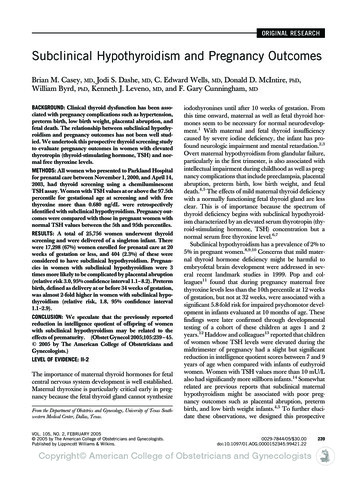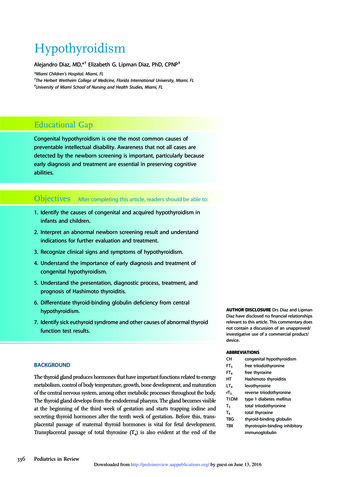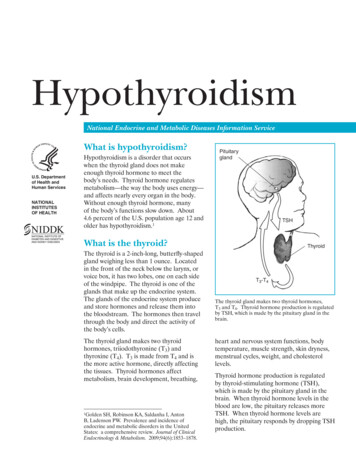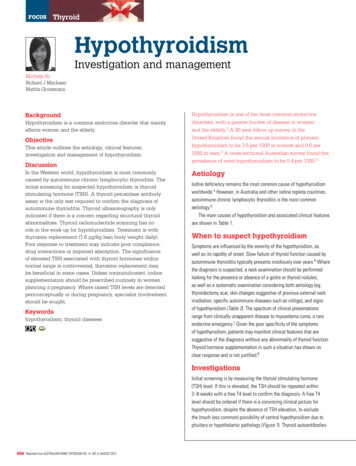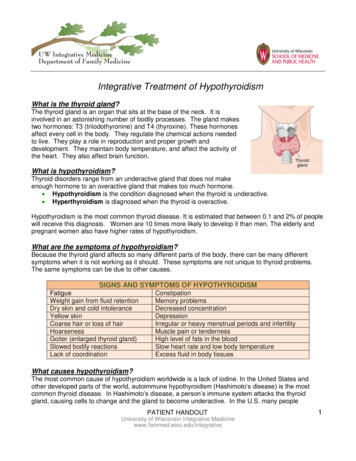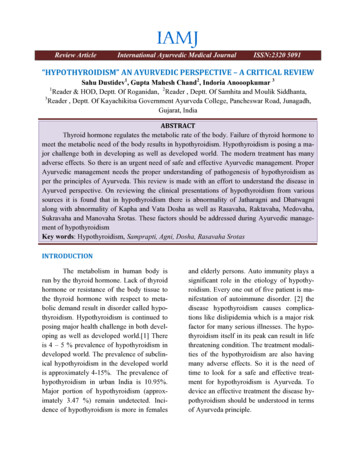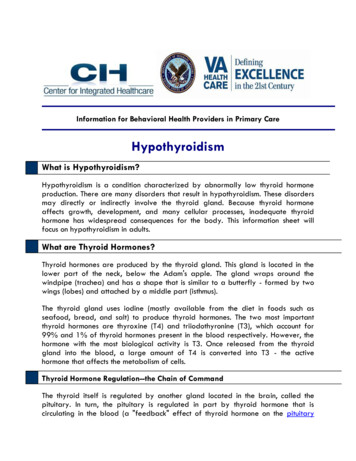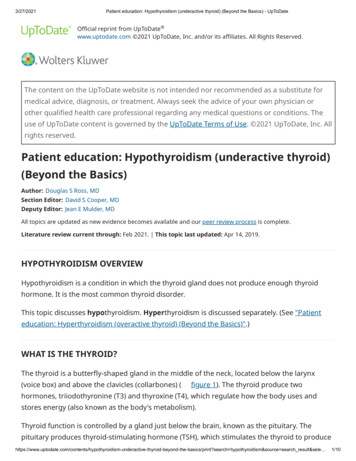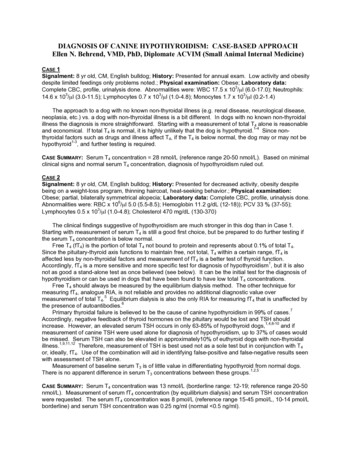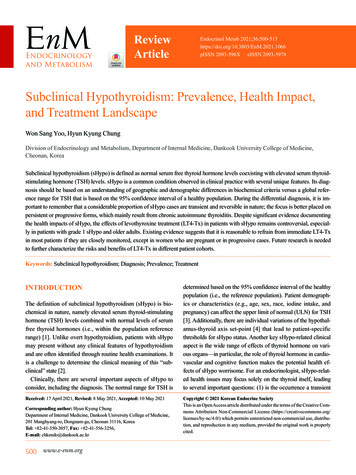
Transcription
ReviewArticleEndocrinol Metab 66pISSN 2093-596X · eISSN 2093-5978Subclinical Hypothyroidism: Prevalence, Health Impact,and Treatment LandscapeWon Sang Yoo, Hyun Kyung ChungDivision of Endocrinology and Metabolism, Department of Internal Medicine, Dankook University College of Medicine,Cheonan, KoreaSubclinical hypothyroidism (sHypo) is defined as normal serum free thyroid hormone levels coexisting with elevated serum thyroidstimulating hormone (TSH) levels. sHypo is a common condition observed in clinical practice with several unique features. Its diagnosis should be based on an understanding of geographic and demographic differences in biochemical criteria versus a global reference range for TSH that is based on the 95% confidence interval of a healthy population. During the differential diagnosis, it is important to remember that a considerable proportion of sHypo cases are transient and reversible in nature; the focus is better placed onpersistent or progressive forms, which mainly result from chronic autoimmune thyroiditis. Despite significant evidence documentingthe health impacts of sHypo, the effects of levothyroxine treatment (LT4-Tx) in patients with sHypo remains controversial, especially in patients with grade 1 sHypo and older adults. Existing evidence suggests that it is reasonable to refrain from immediate LT4-Txin most patients if they are closely monitored, except in women who are pregnant or in progressive cases. Future research is neededto further characterize the risks and benefits of LT4-Tx in different patient cohorts.Keywords: Subclinical hypothyroidism; Diagnosis; Prevalence; TreatmentINTRODUCTIONThe definition of subclinical hypothyroidism (sHypo) is biochemical in nature, namely elevated serum thyroid-stimulatinghormone (TSH) levels combined with normal levels of serumfree thyroid hormones (i.e., within the population referencerange) [1]. Unlike overt hypothyroidism, patients with sHypomay present without any clinical features of hypothyroidismand are often identified through routine health examinations. Itis a challenge to determine the clinical meaning of this “subclinical” state [2].Clinically, there are several important aspects of sHypo toconsider, including the diagnosis. The normal range for TSH isReceived: 17 April 2021, Revised: 8 May 2021, Accepted: 10 May 2021Corresponding author: Hyun Kyung ChungDepartment of Internal Medicine, Dankook University College of Medicine,201 Manghyang-ro, Dongnam-gu, Cheonan 31116, KoreaTel: 82-41-550-3057, Fax: 82-41-556-3256,E-mail: chkendo@dankook.ac.kr500 www.e-enm.orgdetermined based on the 95% confidence interval of the healthypopulation (i.e., the reference population). Patient demographics or characteristics (e.g., age, sex, race, iodine intake, andpregnancy) can affect the upper limit of normal (ULN) for TSH[3]. Additionally, there are individual variations of the hypothalamus-thyroid axis set-point [4] that lead to patient-specificthresholds for sHypo status. Another key sHypo-related clinicalaspect is the wide range of effects of thyroid hormone on various organs—in particular, the role of thyroid hormone in cardiovascular and cognitive function makes the potential health effects of sHypo worrisome. For an endocrinologist, sHypo-related health issues may focus solely on the thyroid itself, leadingto several important questions: (1) is the occurrence a transientCopyright 2021 Korean Endocrine SocietyThis is an Open Access article distributed under the terms of the Creative Com mons Attribution Non-Commercial License (https://creativecommons.org/licenses/by-nc/4.0/) which permits unrestricted non-commercial use, distribu tion, and reproduction in any medium, provided the original work is properlycited.
Management of Subclinical Hypothyroidismor persistent phenomenon, (2) what are the cause(s), (3) what isthe risk of progression to overt disease, and (4) what should bedone to address the health of the patient’s thyroid? While themost important issue may be the decision of whether to initiatelevothyroxine treatment (LT4-Tx), the existing evidence is notclear-cut, making clinical decisions such as when to treat andthe best course of follow-up challenging and a matter of debate.In this review, recent clinical and epidemiological data forsHypo are introduced to discuss: (1) the diagnosis and prevalence of sHypo, (2) its natural course and etiology, (3) its healthimpact, and (4) treatment recommendations.DIAGNOSIS AND PREVALENCE OF sHyposHypo is a common disease with a reported overall prevalenceof 3.1% in Korea (males 2.26%, females 4.04%; Korean National Health and Nutrition Examination Survey [KNHANESVI]), 4.3% in the USA (National Health and Nutrition Examination Survey [NHANES] III) [5,6], and as high as 20% depending on the study population [7]. In fact, the prevalence might beeven higher than estimated as a considerable proportion of thepopulation may have undiagnosed sHypo [8]. The reportedprevalence of sHypo in different countries is presented in Table1 [5,6,8-14]. Several factors may influence differences in prevalence. First, the normal range of serum TSH could vary acrossdifferent countries or ethnic groups [15]. The mean level andULN of serum TSH are 2.16 and 7.03 mIU/L, respectively, inKoreans (KNHANES), whereas the corresponding levels are1.40 and 4.12 mIU/L, respectively, in the USA (NHANES III)[6,16]. The markedly higher levels of TSH in Koreans may beexplained by the excess iodine intake or genetic differences inthe TSH set-point [16] and this discrepancy provides a clear example of why a single international cut-off for TSH cannot berecommended for the diagnosis of sHypo. Age is another important factor to consider; serum TSH levels increase with age,meaning that a mild increase may be normal for older individuals [17]. Therefore, using a single ULN for TSH for all agegroups may lead to the misclassification of elderly individualsas having sHypo, which in turn could impact prevalence estimates. Importantly, age-related differences vary by country; theTSH median and 97.5th percentile increased progressively withage in the United States population [18], but in Koreans, theTSH and age graph was U-shaped (higher in younger and oldersubjects) [19,20]. Certain other factors (e.g., pregnancy, obesity,and dwelling conditions) can also impact the TSH referencerange. TSH levels are usually lower during pregnancy, especially in the first trimester, and gradually rise in the second andthird trimesters [21]. The extent of this reduction varies significantly based on race and country. Compared to Western countries, Asian countries, including China and Korea, show a modest reduction in the ULN of TSH during the first trimester[22,23]. Thus, most guidelines recommend developing population-based, age-specific, and trimester-specific reference rangesfor serum TSH based on local data [21].When age and race-specific reference ranges for TSH are notavailable, the ULN for TSH can be considered 4.0 to 6.0 mIU/L.sHypo is often classified as grade 1 (TSH level between theULN and 9.9 mIU/L) and grade 2 (TSH levels 10 mIU/L orhigher) [24]. Grade 1 can also be subdivided into those withTSH levels below 7 and between 7.0 and 9.9 mIU/L in youngerTable 1. Prevalence of Subclinical HypothyroidismPrevalence, %YearCountryAge, yrTSH threshold,mIU/LWomenMen1977UK (the Whickham survey) 18 6.07.52.81981Sweden (women only)44–668.0–14.45.11990USA (nursing home) 60 4.514.69.7[11]1993Japan (health examination)Mean 46 5.02.10.4[12]2000USA (the Colorado study) 18 5.19.1 (men and women)[13]2002USA (NHANES III) 12 4.54.3 (men and women)[6]2006The Netherlands2017South Korea (KNHANES VI)2019Europe (meta-analysis)Reference[9][10] 18 (46% 69) 4.04.93.0[14] 10 6.864.02.3[5] 4.54.82.7[8]TSH, thyroid-stimulating hormone; NHANES, National Health and Nutrition Examination Survey; KNHANES, Korean National Health and NutritionExamination Survey.Copyright 2021 Korean Endocrine Societywww.e-enm.org501
Yoo WS, et al.patients ( 65 years) for classifying the benefit of LT4-Tx [25].Most patients with sHypo (90%) have serum TSH levels below10 mIU/L (i.e., grade 1).Another factor to consider in the differential diagnosis forsHypo is the presence of inter-individual differences in the TSHset-point [26]. Everyone has a unique set-point of the hypothalamic-pituitary-thyroid axis, which is genetically determined[4]. This concept is useful for explaining the different signs andsymptoms of patients who have the same level of TSH. Theoretically, it is possible that a particular TSH level may be abnormal for one individual’s set-point, but still be within the normalreference limit. Therefore, it would be important to interpretsHypo-relevant laboratory data considering not only the fixedTSH level, but also serial changes in TSH levels concurrentlywith a careful clinical assessment.NATURAL COURSE AND ETIOLOGY OFsHypoAlthough the rate of progression to overt hypothyroidism mayvary depending on several factors [27], it is not high in thosewith grade 1 sHypo (2% to 4% per year) [3]. For women withpositive thyroid peroxidase antibodies (TPOAbs) and a baselineTSH between 2.5 and 4 mIU/L, the risk of progression to overthypothyroidism is roughly 1% per year [28]. In children and ad-olescents, chronic autoimmune thyroiditis (CAT) usually remains static for years and recovery is more common [29]. Without considering causative factors, the overall recovery rate forgrade 1 sHypo is 30% over 3 years and 60% over 5 years [3,30].These data reveal that there are many patients with transientsHypo. In response to various external and internal stimuli, serum TSH levels could change transiently without thyroid diseases. Iodine or food with high iodine levels, medications, ortesting reagents are classic examples of external stimuli [16,31].Serum TSH concentrations could fluctuate as a result of diurnalor seasonal variations [32,33], and transiently increase duringthe course of non-thyroidal illness or with several drugs. In patients who are taking LT4, an inadequate dosage or consumption of substances that prevent absorption or increase the clearance of LT4 could also lead to sHypo. In these transient cases,only a re-evaluation of thyroid function without LT4-Tx couldbe recommended [34]. Thus, the first step of sHypo management is to confirm the persistence of TSH elevation and excludetransient cases. The causative factors of sHypo are summarizedin Table 2.Persistent sHypo mainly implies CAT, and the tendency forprogression to overt hypothyroidism might be related to the degree of immunological deterioration and thyroid reserve. Themost important risk factors have been shown to be serum TSHlevels and TPOAb positivity [35]. Higher TSH levels are asso-Table 2. Etiology of Subclinical HypothyroidismTransient, reversible causesPersistent, progressive causesThyroid diseasesTransient thyroiditis (subacute, postpartum thyroiditis)Related to treatment of thyroid diseases (LT4) (underlying thyroiddisease or after destructive treatment: thyroidectomy, RAI)-Inadequate replacement (dosage, noncompliance)-Drug interaction (iron, calcium, cholestyramine, fiber, etc.)-Increased clearance (phenytoin, carbamazepine, phenobarbital)Chronic autoimmune thyroiditis (Hashimotothyroiditis)Infiltrative diseases (amyloidosis, sarcoidosis, primarythyroid lymphoma, Riedel thyroiditis)Not related to thyroiddiseaseNon-thyroidal diseasesNon-thyroidal disease-Sick euthyroid syndrome (especially during the recovery phase)-Advanced chronic kidney disease, dialysis-Adrenal insufficiency-H ead and neck malignancies (radiation therapy on-Marked obesity (typically with body mass index 40 kg/m2)neck area)MedicationsElderly people-Iodine and iodine containing medications (amiodarone, radiographiccontrast agents)-Lithium carbonate-Cytokine (interferon alpha)-Other drugs (aminoglutethimide, thioamide, sulfonamides,sulfonylurea, ritonavir, amphetamine, etc.)Toxic substances (industrial and environmental agents)Assay interference (heterophilic antibodies or macro TSH)Seasonal (wintertime) and diurnal increase of TSHLT4, levothyroxine; RAI, radioactive iodine; TSH, thyroid-stimulating hormone.502 www.e-enm.orgCopyright 2021 Korean Endocrine Society
Management of Subclinical Hypothyroidismciated with a higher rate of TPOAb positivity, especially inwomen [6,28]. In patients with existing thyroid disease [36] orwithout a history of thyroid disease, prospective studies demonstrated that the most important predictor of progression was theserum TSH concentration [37]. In addition, iodine intake [38],cigarette smoking [39], racial differences [6], and cold environmental temperatures [33] have been identified as risk factors.Thyroid sonographic findings, such as markedly decreasedechogenicity and multifocal pseudonodular hypoechoic infiltration, could also be used as indicators of inflammatory activity inCAT [40]. There is no evidence that early LT4-Tx would helpprevent the development of overt hypothyroidism. Thus, interms of progression to overt hypothyroidism, the “wait andsee” strategy would be acceptable in most individuals with sHypo (grade 1), especially in TPOAb-negative patients.GENERAL CONSIDERATIONS FOR THEAPPROACH TO sHypoAgeThe aging process plays an important role in thyroid anatomyand physiology. Anatomical changes with aging include reduction in weight of the gland and the size of follicles, as well as increased fibrosis and lymphocytic infiltration. The half-life ofthyroid hormone slightly increases with age and its synthesis itself could decrease, although this is not a known contributor tothyroid dysfunction except in cases of existing thyroid disease[41]. If the global ULN of TSH was used for all age groups, theprevalence of sHypo would be increased in the elderly population [42]. The rate of TPOAb positivity also increases with agein the healthy population without thyroid disease and decreasesagain in those 80 years or older [41].In the elderly population, CAT is also the most common causeof sHypo [43]. Since the manifestations may be erroneously ignored as the effect of aging, sHypo may remain unrecognized,especially since the decline in thyroid function is gradual. Previous studies found that older adults with persistent sHypo did nothave elevated risks of coronary heart disease, heart failure, cardiovascular death [44], or cognitive dysfunction [45]. In a recentdouble-blind, randomized, placebo-controlled trial (the Thyroidhormone Replacement for Untreated older adults with Subclinical hypothyroidism–a randomized placebo-controlled Trial[TRUST]), LT4-Tx showed no benefits in older patients withmild sHypo [46]. Furthermore, polypharmacy and the risk ofLT4 overtreatment are non-negligible concerns, especially infrail, elderly patients. Altogether, a conservative approach to theCopyright 2021 Korean Endocrine Societymanagement of sHypo (i.e., without LT4-Tx) could be the mostreasonable and safest choice in elderly patients with sHypo.In children, thyroid hormone has unique roles, such as exerting a maturational effect on brain development in the first 3years of life, and its effects on linear growth persist until epiphyseal closure in adolescence. The causes of sHypo are morelikely to be idiopathic or genetic in younger children versusCAT in adolescents [47]. In iodine-rich areas, excess iodinecould be associated with sHypo in children [48]. In general,sHypo in children is a benign and self-remitting condition [49].Most children with sHypo are usually asymptomatic and thereis no known association with adverse effects on growth or bonehealth [47]. The risk of progression to overt hypothyroidismseems to be negligible in idiopathic and mild cases of sHypo inchildren [50], although the risk of deterioration of thyroid function is somewhat higher in CAT-related sHypo [51,52]. Becauseof the lack of high-quality studies or consensus guidelines, it remains a matter of debate whether to treat children with sHypo[53]. Starting LT4-Tx only in sHypo infants 1 month until 3years of age is recommended based on concerns related to thyroid-dependent brain development [47]. Regular (every 6 to 12months) monitoring of TSH with TPOAb would be needed incases of sHypo due to CAT, and LT4-Tx should be stronglyconsidered in patients with a TSH level 10 mIU/L [47].SexThe prevalence of sHypo is higher in women than in men [6],due in part to the higher prevalence of CAT in women and higher estrogen levels [54]. During pregnancy, metabolic needs increase, which leads to changes in the thyroid-pituitary axis [55].Reduction of the lower and upper limit of TSH is a hallmark ofpregnancy, typically in the first trimester, as a result of the elevated serum human chorionic gonadotropin levels directly stimulating the TSH receptor [56]. During the second and third trimesters, the TSH reference range increases, although it remainslower than in healthy non-pregnant women [57]. The extent ofthis reduction varies across different ethnic groups and according to iodine intake status. Thus, if possible, it is strongly recommended to define population-based, trimester-specific reference ranges for serum TSH through local population data [21].If not available, it is typical to set the ULN of TSH as 0.1 to 2.5mIU/L in the first trimester, 0.3 to 3.0 mIU/L in the second trimester, and 0.3 to 3.0 or 3.5 mIU/L in the third trimester. sHypoduring pregnancy is defined using TSH ULNs of 2.5 mIU/Lin the first trimester, 3.0 mIU/L in the second trimester, and 3.0 or 3.5 mIU/L in the third trimester [57]. The latest Ameri-www.e-enm.org503
Yoo WS, et al.can Thyroid Association guidelines recommend that the ULN inpregnancy could be calculated by subtracting 0.5 mIU/L fromthe non-pregnant reference range [21].Overt hypothyroidism during pregnancy should be considereda dangerous condition to both the mother and fetus. sHypo during pregnancy is also associated with multiple adverse maternaland neonatal outcomes [58]. Almost all studies have demonstrated an increased risk of pregnancy-specific complications(e.g., pregnancy loss, preterm delivery, and placental abruption)associated with elevated maternal TSH concentrations [21,59].These outcomes are even worse in the presence of TPOAb.Thus, a more aggressive approach with LT4-Tx would be recommended in pregnant women [21]. Based on concerns of theadverse effects on pregnancy, it would be better to manage sHypo aggressively in women who are undergoing in vitro fertilization or planning to conceive, or even in all women of childbearing age [21]. Although the value of LT4-Tx in preventingadverse outcomes remains uncertain, sHypo detected beforeconception should be treated, and doing so may also be considered in the first trimester [47].SymptomsFatigue, muscle weakness, weight gain, cold intolerance, andconstipation have been reported as sHypo symptoms [13]. Mildmemory impairment and mood changes have been identified inmiddle-aged patients with grade 2 sHypo [60]. Functional magnetic resonance imaging suggested that working memory maybe impaired in individuals with sHypo [61]. However, a smallproportion of asymptomatic sHypo subjects have superior wellbeing compared with euthyroid individuals as assessed usinggeneral health questionnaires and neuropsychological tests [62].In a meta-analysis, the risk of depression in individuals withsHypo was significantly higher than in their euthyroid counterparts [63], while other studies only confirmed this relationshipin younger patients [64-66]. Yet another study identified no linkbetween depression and sHypo in young and middle-agedadults [67].When managing patients with psychoneurotic symptoms,there are several points to remember. First, it should be kept inmind that these symptoms (e.g., fatigue, depression, weakness)are extremely common in the general population (especially elderly patients), meaning that their presence in an individual canbe distinct from sHypo. A second point to consider is the “labeling effect,” whereby patients who learn about their thyroid condition are more likely to report related symptoms. This observation is supported by findings from a population-based study504 www.e-enm.orgsuggesting that there was no correlation between thyroid function and self-reported depression overall, but that within thesubgroup with known thyroid disease, there was an increasedprevalence of depression, even in those with normal TSH levels[68].Previous treatment guidelines have recommended the use ofLT4-Tx based mainly on symptoms and serum TSH levels (Table 3); however, recent data are not consistent with these recommendations. A systematic review and meta-analysis failed tofind an effect of LT4-Tx on symptomatic improvement [69]. Ina prospective analysis involving adults with sHypo aged 80years and older, LT4-Tx was not significantly associated withimprovement in hypothyroid symptoms or fatigue [70]. Asmentioned above, the TRUST study also found no benefit ofLT4-Tx on thyroid-related symptoms in elderly people withmild sHypo [46]. Altogether, the timing of LT4-Tx initiationshould be carefully considered in relation to symptomatic improvement, especially in elderly patients with mild sHypo.On physical examination, the presence of goiter could be aclue suggesting CAT, although CAT may also present withoutgoiter [71]. To rule out other causes, it is recommended to measure serum TPOAb and check the history of the goiter, its size,and the co-occurrence of symptoms (e.g., pain).ORGAN-SPECIFIC CONSIDERATIONS INTHE MANAGEMENT OF sHypoCardiovascular functionDoppler echocardiographic data demonstrated that sHypo is related to left ventricular (LV) diastolic function, a slowed rate ofrelaxation time, and impaired ventricular filling (exercise), leading to LV systolic dysfunction [72]. Vascular abnormalities havealso been reported in patients with sHypo [73]. Grade 2 sHypowas found to be associated with increased carotid intima-mediathickness in a meta-analysis [74]. However, clinical data are notconsistent with these laboratory and diagnostic findings. Severalstudies found correlations between sHypo and cardiovasculardisease [75,76], including a comprehensive meta-analysis thatdemonstrated an association between cardiovascular diseaserisk and sHypo [77]. Long-term cardiovascular outcomes aftercoronary bypass grafting in patients with sHypo showed a poorprognosis [78]. However, data from a consortium of cohortstudies with data from more than 75,000 participants (ThyroidStudies Collaboration) revealed no correlation with the risk ofatrial fibrillation [79], heart failure [80], stroke [81], coronaryheart disease [82], mortality [83], and sHypo. Only in a subCopyright 2021 Korean Endocrine Society
Management of Subclinical HypothyroidismTable 3. Current Guidelines on LT4-Tx for Subclinical HypothyroidismConsider LT4-TxObserve without LT4-TxReferenceAmerican ThyroidAssociation (2012)TSH 10 mIU/L, age 70 yearsTSH 4–10 mIU/L, age 65 years with symptomsTSH 10 mIU/L, age 70 yearsTSH 4–10 mIU/L, age 65 years[100]European ThyroidAssociation (2013)TSH 10 mIU/L, age 70 yearsTSH 10 mIU/L, age 70 years with symptomsTSH 10 mIU/L, age 70 years with clearsymptoms or high cardiovascular riskTSH 10 mIU/L without symptoms, age 70 yearsTSH 10 mIU/L, age 70 years[101]Clinical practice guideline(2017)TSH 10 mIU/L, age 70 yearsEspecially, symptoms ( ), cardiac risk factors ( )6 months LT4-Tx trial (may)TSH 4.5 to 7 mIU/L with symptomsTSH 7 to 10 mIU/L, age 70 years, withsymptoms regardless of age, cardiac risk factors,TPOAb( )TSH 10 mIU/L, age 70 years[24]UpToDate (2018)TSH 7 mIU/L, age 65/70 years with symptoms TSH 7 mIU/L, age 65/70 yearsTSH 7–10 mIU/L, age 65 yearsTSH 7 mIU/L, age 65/70 years without symptomsTSH 7–10 mIU/L, age 65/70 years with symptoms TSH 7–10 mIU/L, age 65/70 years withoutTSH 10 mIU/Lsymptoms[102]National Institute for Healthand Care Excellence(NICE) guidelines (2018)TSH 10 mIU/L, age 70 yearsTSH 4–10 mIU/L, age 65 years with symptomsTSH 10 mIU/L, age 70 yearsTSH 4–10 mIU/L, age 65 years[103]Clinical practice guideline(2019)Only women who are or trying to become pregnantor patients with TSH 20 mIU/LAlmost all adults[104]LT4-Tx, levothyroxine treatment; TSH, thyroid-stimulating hormone; TPOAb, thyroid peroxidase antibody.analysis, higher cardiovascular risk was associated with the severity of sHypo and the presence of TPOAb [25].The effects of LT4-Tx on cardiovascular outcomes are alsoinconclusive. In a retrospective study, LT4-Tx reduced the riskof coronary heart disease events [84], but other studies failed toconfirm improvement of the LV ejection fraction after 52 weeksof LT4-Tx in patients with sHypo and acute myocardial infarction [85]. Although the TRUST study failed to confirm a positive effect of LT4-Tx on the occurrence of serious cardiovascular events, such as atrial fibrillation and heart failure [46], it focused only on elderly patients, and participants with TSH 10mIU/L accounted for only 5% of the study population. Therefore, it would be inappropriate to extrapolate the TRUST data tosubjects with grade 2 sHypo and those who are 65 years old.Based on the results available to date, it may be reasonable topay additional attention to patients with grade 2 sHypo at highrisk of cardiovascular disease; however, existing evidence assessing the therapeutic effects of LT4-Tx on cardiovascular riskis not yet sufficient. Further large, prospective multi-centerstudies are needed to assess the usefulness of LT4-Tx for preventing cardiovascular disease in sHypo, especially in youngerpatients.Copyright 2021 Korean Endocrine SocietyCognitive functionWhen a clinician faces a patient with sHypo and symptoms ofdementia, the question may arise of whether a link exists between these two conditions. In a population-based cohort of elderly people, sHypo was not associated with mild cognitive impairment [66,86]. In another meta-analysis, no correlation wasfound between sHypo and cognitive impairment in individualsyounger than 75 years who had higher TSH concentrations [45].sHypo demonstrated no association with a faster decline inMini-Mental State Examination scores over time [87]. Anothersystematic review found no evidence of an association betweensHypo and cognitive impairment in people over 60 years [88].Thus, there is a shortage of evidence to support a correlation between sHypo and cognitive dysfunction. LT4-Tx cannot yet bejustified as a treatment to improve cognitive function, especiallyin elderly people.Musculoskeletal, kidney, and liver functionsUnlike subclinical hyperthyroidism, which has a significant impact on fracture risk, a meta-analysis found no association between sHypo and fracture risk [89]. Additionally, no associationhas been reported between sHypo and serial bone mineral den-www.e-enm.org505
Yoo WS, et al.sity measurements [90] or bone turnover markers and bone loss[91]. In a cross-sectional, prospective study that assessed the associations of subclinical thyroid dysfunction with frailty and thefive frailty subdomains (sarcopenia, weakness, slowness, exhaustion, and low activity), sHypo was not consistently associated with the overall frailty components [92]. A randomizedcontrolled study, the Prospective Study of Pravastatin in the Elderly at Risk (PROSPER), found no evidence that sHypo contributes to decreased functional capacity [93]. Altogether, sHypois thought to have no correlation with the deterioration of musculoskeletal function.In end-stage renal disease, a higher prevalence of sHypo hasbeen noted compared with the general population [94]. In patients with sHypo and chronic kidney disease (CKD), LT4-Txattenuated the decline in renal function [95]. sHypo was associated with higher mortality than the euthyroid state in patientswith renal failure requiring hemodialysis [96]. These resultsdemonstrated that sHypo worsens the clinical course of CKD.However, a meta-analysis found no correlation between sHypoand decline in kidney function [97].Overt hypothyroidism is known to be associated with the presence and severity of nonalcoholic fatty liver disease (NAFLD);however, evidence of an association between NAFLD and sHypo is insufficient to date. In a cross-sectional study, individualswith sHypo and fatty liver had higher risks for metabolic syndrome, insulin resistance, and a higher coronary artery calcification score than those with sHypo and no fatty liver [98]. In another small-scale, randomized controlled trial, LT4-Tx demonstrated benefits on NAFLD in sHypo patients with dyslipidemia[99]. Larger-scale, well-designed prospective studies to confirmthe correlation between sHypo and liver function are required.MANAGEMENT OF sHypoSeveral clinical guidelines have provided a path for clinical decision-making for sHypo (Table 3) [24,100-104]. These guidelines primarily integrate patient age and serum TSH levels. Other parameters such as the presence of TPOAb, symptoms, cardiac risk factors, and goiter also be included for reference. Evenwith these guidelines, however, clinicians are often confrontedwith difficult challenges in the management of sHypo. Since theguidelines do not apply age-adjusted reference ranges of TSH,the suboptimal use of a single TSH cut-point value may still beapplied to patients. Although the adverse health impacts of sHypo have been reported, data confirming the benefits of LT4-Txremain unclear [101]. When using LT4-Tx, the appropriate du-506 www.e-enm.orgration of treatment has not yet been empirically defined. Whenmanaging patients without LT4-Tx, the ideal duration andschedule of follow-up have likewise not been clearly defined.The cost-benefit effect or possible risks of LT4-Tx in sHypo arealso unclear. The remaining uncertainties have caused persistentconcerns and dissatisfaction among patients, regardless ofwhether they are treated.Based on the paucity o
progression to overt hypothyroidism might be related to the de-gree of immunological deterioration and thyroid reserve. The most important risk factors have been shown to be serum TSH levels and TPOAb positivity [35]. Higher TSH levels are asso-Table 2. Etiology of Subclinical Hypothyroidism Transient, reversible causes Persistent, progressive .
